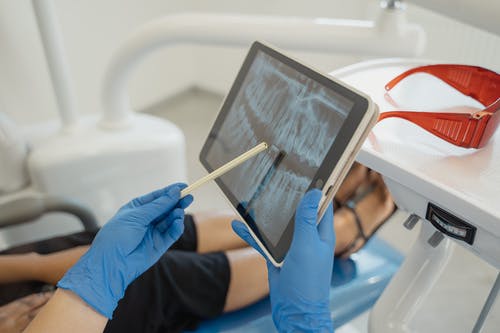A beautiful, aligned smile can boost your confidence and oral health. Invisalign has become popular for individuals seeking orthodontic treatment because of its discreet, comfortable, and effective approach to straightening teeth. If you’re considering Invisalign, you might wonder what to expect during your first consultation. In this article, we’ll explore Invisalign, discuss when to consult for treatment, and provide an in-depth look at what to anticipate during your initial Invisalign consultation. We’ll also touch briefly on dental veneers as an alternative option.
What Is Invisalign?
Invisalign is an innovative orthodontic treatment system to correct misaligned teeth and improve smiles. Unlike traditional braces with metal brackets and wires, Invisalign utilizes a series of clear, removable aligners made from medical-grade plastic. These aligners are custom-made dental solutions in Dallas for each patient and gradually shift the teeth into their desired positions.
When to Consult for Invisalign Treatment?
Knowing when to consult for Invisalign treatment is essential to address orthodontic issues effectively. Here are some signs and factors that indicate it’s time for an Invisalign consultation:
- Misaligned Teeth: If you have crooked or misaligned teeth that affect your smile, bite, or overall oral health, Invisalign may be a suitable advanced teeth straightening solution. Invisalign can address various degrees of teeth misalignment, from mild to moderate cases.
- Gaps or Spacing Issues: Invisalign can help close gaps between teeth or correct uneven spacing, creating a more harmonious smile.
- Overcrowding: Overcrowded teeth can lead to dental health problems. Invisalign can gradually create space by repositioning teeth improving aesthetics and oral hygiene.
- Bite Problems: Invisalign can address bite problems, including overbites, underbites, crossbites, and open bites. Correcting these issues can enhance oral function and reduce the risk of dental complications.
- Self-Consciousness About Your Smile: Invisalign can provide a discreet and effective solution if you’re self-conscious about your smile due to teeth misalignment or other cosmetic concerns. The clear aligners are nearly invisible when worn, allowing you to undergo treatment without feeling self-conscious.
What to Expect in the First Invisalign Consultation
Your first Invisalign consultation is a crucial step in your orthodontic journey. It sets the foundation for your treatment plan and gives you a comprehensive understanding of what to expect. Here’s a detailed breakdown of what you can anticipate during your initial Invisalign consultation:
1. Comprehensive Evaluation
The consultation commences with a thorough assessment conducted by an experienced Invisalign provider, often a dentist or orthodontist. This evaluation serves as the foundation of your treatment journey. The provider will:
- Examine your oral health: This includes assessing the condition of your teeth, gums, and overall oral health. Dental issues, such as cavities or gum disease, must be addressed before starting Invisalign.
- Evaluate teeth alignment: The provider will examine the alignment of your teeth, noting any misalignments, gaps, overcrowding, or bite issues. This assessment helps determine whether Invisalign is appropriate for your dental concerns.
- Discuss your concerns and goals: You can express your dental concerns and share your treatment goals. Open communication is essential in tailoring your Invisalign treatment plan to your expectations and needs.
2. Discussion of Treatment Goals
During the consultation, you’ll engage in a discussion with your Invisalign provider regarding your treatment objectives. This conversation is vital because it helps the provider gain insight into what you hope to achieve with Invisalign. Whether your goal is to achieve a straighter smile, address bite issues, or enhance your overall dental aesthetics, your input will guide the development of your personalized treatment plan.
3. 3D Scanning or Impressions
Digital impressions or 3D scans of your teeth will be taken to create a precise and customized treatment plan. This advanced technology ensures accurate images of your dental structure. The digital impressions or scans create a series of clear aligners that will gradually shift your teeth into their desired positions. This step is crucial in tailoring your treatment plan to your unique dental anatomy.
4. Treatment Plan Presentation
Once the digital impressions or scans are complete, your Invisalign provider will present a comprehensive treatment plan. This plan will detail various aspects of your Invisalign journey, including:
- Expected duration: The provider will outline the estimated length of your treatment, giving you a timeline for achieving your desired results.
- Aligner count: You’ll be informed about the number of aligners you receive throughout your treatment. Each aligner is designed to move your teeth progressively.
- Anticipated results: Your provider will discuss the expected outcomes of your treatment. You can review these expectations and ask questions or express concerns.
5. Cost and Insurance Information
The cost of your Invisalign treatment will be explained during your consultation. If needed, your provider will also discuss various payment options and potential financing plans. If dental insurance covers orthodontic treatment, your provider will guide you on maximizing your insurance benefits.
6. Custom Aligner Fitting
If you proceed with Invisalign treatment following the consultation, your provider will initiate creating your custom aligners. These aligners are precisely designed to fit your mouth comfortably. The fitting ensures that your aligners effectively guide your teeth into their desired positions.
7. Care and Maintenance
You’ll receive detailed instructions on how to care for your aligners. This includes guidance on wearing them for the recommended 20-22 hours daily and proper cleaning and maintenance to ensure their longevity and effectiveness. Your provider will also emphasize the importance of maintaining good oral hygiene throughout your Invisalign treatment.
What About Dental Veneers?
While Invisalign effectively addresses teeth misalignment, dental veneers serve a different purpose in cosmetic dentistry. Dental veneers are thin, custom-made shells made of porcelain or composite resin. They are bonded to the front surfaces of teeth to improve their appearance. Veneers are often chosen for cosmetic enhancements, such as covering dental stains, discoloration, chips, and minor imperfections. Unlike Invisalign, veneers do not physically move teeth into new positions but provide an instant makeover for a more aesthetically pleasing smile. Click here to learn more about dental veneers.
Conclusion
Your first Invisalign consultation is a significant step toward achieving a straighter, more confident smile. Invisalign offers a discreet, comfortable, and effective orthodontic solution for addressing various dental concerns. By consulting with an experienced Invisalign provider, you can expect a comprehensive evaluation, a customized treatment plan, and guidance on achieving your dental goals. Whether you choose Invisalign or explore alternative options like dental veneers, the key is to prioritize your oral health and cosmetic preferences by working closely with a qualified dental professional.



